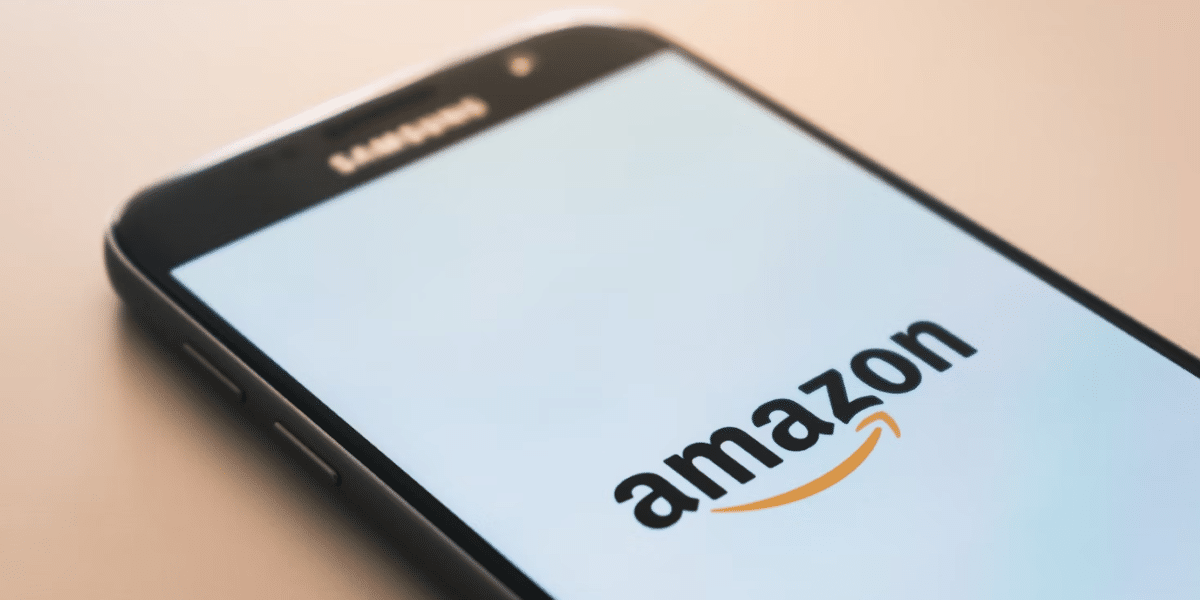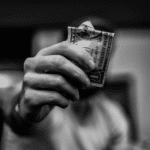By: Prateek S.
In the vast e-commerce landscape, Amazon stands as an undisputed giant, connecting millions of buyers with a diverse array of sellers worldwide.
While this platform offers unparalleled convenience and accessibility, it has also become a breeding ground for a persistent problem: counterfeit products.
Although there are several best selling products on Amazon, the proliferation of counterfeit items poses serious concerns for both consumers and legitimate sellers, undermining trust and integrity within the marketplace.
In this article, we delve into the multifaceted nature of this issue, shedding light on its prevalence, consequences, and the efforts undertaken by Amazon to combat it.
From understanding the root causes of counterfeiting to examining the impact on consumers and genuine businesses, we aim to equip you with the knowledge to make informed decisions as a buyer or seller on the platform.
Quick Guide
What are counterfeit products on Amazon?
How is Amazon addressing the problem of counterfeit products on its platform?
Is there an estimated percentage of counterfeit products among all Amazon listings?
What are the consequences for sellers caught selling counterfeit products on Amazon?
How can sellers remove counterfeit listings from Amazon?
What is the process for reporting suspected counterfeit or infringing products on Amazon?
Explaining the role and policies of Amazon’s Counterfeit Crimes Unit?
Conclusion
What are Counterfeit Products on Amazon?
Counterfeit products found on Amazon are items that imitate or replicate genuine products or brands, falsely claiming to be authorized or produced by the original manufacturer.
These fraudulent goods can span across various categories, including luxury items, electronics, clothing, toys, and cosmetics. Although they may seem like a bargain due to their lower prices, counterfeit products often lack the quality and safety standards of authentic items, posing potential risks to consumers.
Over time, Amazon has faced criticism for not adequately addressing the issue of counterfeit products on its platform. To combat this problem, the company has implemented several measures. These include investments in advanced technology and the hiring of dedicated staff to monitor and remove fraudulent listings.
Despite these efforts, counterfeit products remain a persistent challenge on Amazon.
By taking a proactive approach, buyers can protect themselves from falling victim to counterfeit scams and ensure a safer and more satisfying shopping experience on Amazon.
Is There an Estimated Percentage of Counterfeit Products among all Amazon Listings?
In recent years, the rise of counterfeit products on Amazon has become a concerning issue, with estimates suggesting that anywhere from 10% to 60% of Amazon listings could be counterfeit. This problem is particularly pronounced in high-value and luxury product categories.
According to a new report, Amazon has taken measures to combat this growing problem, blocking a staggering 10 billion attempted counterfeit listings, a significant increase from the 6 billion blocked the previous year. Additionally, the company has proactively destroyed 2 million fake goods found in its warehouses.
To support brands and rights owners in protecting their intellectual property, Amazon has introduced various initiatives. The Amazon Brand Registry empowers businesses to register their trademarks and gain more control over their product listings, while the Transparency program enables brands to add unique codes to their units for easy authenticity verification.
Amazon’s efforts to address the issue of counterfeiting also include the establishment of a dedicated Counterfeit Crimes Unit, which investigates counterfeiters and takes legal action against them and their accomplices.
Despite these proactive measures, Amazon reminds its customers to remain vigilant while shopping on the platform. If they come across any suspicious products, reporting such cases is crucial to ensure a safe and trustworthy shopping experience for all users.
How to Find Counterfeit Products on Amazon?
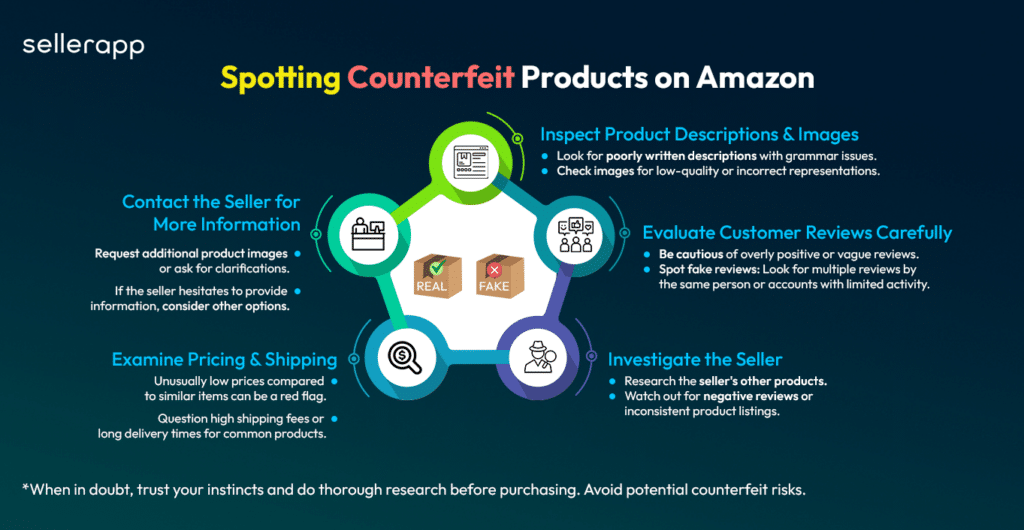
The initial step in identifying a counterfeit product is to carefully assess the seller’s product description and posted images.
Pay close attention to any confusing or poorly written language in the product description, as well as low-quality or inaccurate images, as these can be major warning signs and should make you wary of the item.
Next, take into account the reviews left by other customers about the product. However, be cautious when evaluating reviews, as spotting fake ones can be tricky.
Rely on your judgment to assess the credibility of a review. Unfortunately, reporting tools for fake reviews on websites like Amazon can be unclear and challenging to use, making it more crucial for you to trust your assessment.
If you find a suspicious review, check if the same person has left other reviews. A lack of previous reviews or consistently questionable ones may indicate that the reviews are not genuine.
Always take the time to research the seller thoroughly. Check the other products they offer and look for any warning signs such as frequent complaints or poorly presented product information.
Additionally, examine the details of payments and shipping. If the product’s pricing significantly differs from similar items or if the shipping cost and timeframe seem unreasonable, it could be a signal of a potential counterfeit.
If you still have doubts after your investigation, don’t hesitate to contact the seller directly for more product images, clarifications, or additional information about their company and its relationship to the product. If the seller cannot provide satisfactory answers promptly, it’s best to consider other options and avoid making a purchase.
What are the Consequences for Sellers Caught Selling Counterfeit Products on Amazon?
Selling counterfeit items on Amazon can lead to severe consequences, as the company takes a firm stand against such practices and has implemented measures to combat their sale on its platform.
If Amazon discovers that you are involved in selling counterfeit products, various actions may be taken against you, including:
Suspension or Termination of Selling Privileges: Your ability to sell on the platform may be suspended or terminated. This can have a significant impact on your business operations.
Removal of Listings: Any counterfeit listings found will be promptly removed from the platform, and you may be prohibited from relisting them.
Seizure of Counterfeit Inventory: Amazon may seize any counterfeit products present in your inventory and proceed to have them destroyed.
Legal Liability: Selling counterfeit products can result in legal consequences. You may be held legally liable for your actions and could face legal action from Amazon or the affected brand owners.
Aside from the direct actions taken by Amazon, selling counterfeit products can have broader repercussions. Your reputation as a seller may be severely damaged, and your relationship with customers could be negatively affected. Negative feedback and reviews may accumulate, impacting your future sales and credibility on the platform.
To safeguard your business and maintain a trustworthy presence on Amazon, it is essential to refrain from engaging in counterfeit practices and ensure the authenticity of the products you offer for sale.
How Can Sellers Remove Counterfeit Listings from Amazon?
As a seller, if you discover counterfeit versions of your products on Amazon, follow these steps to take action:
Identify the type of intellectual property (IP) being infringed, such as trademarks, copyrights, or patents.
If you own a registered trademark, utilize Amazon’s Brand Registry to report the infringement and request the removal of counterfeit listings.
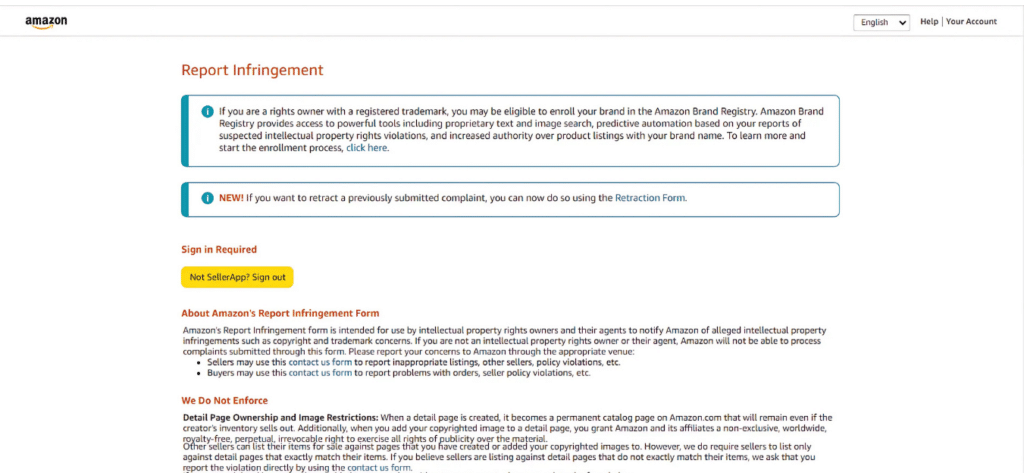
For copyright infringement, report the counterfeit copies through Amazon’s Intellectual Property Policy program.
In case of patent infringement, file a complaint with Amazon using the Intellectual Property Policy program.
Provide evidence of your ownership, such as IP registration, and submit relevant information to support your claim.
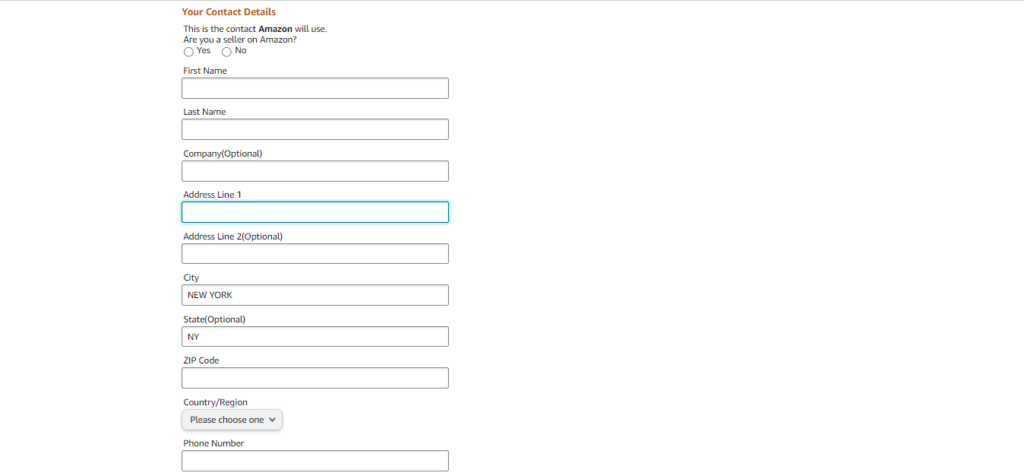
Wait for Amazon to investigate the complaint and take appropriate action, which may involve removing counterfeit products, suspending sellers, or other measures.
Be patient during the process and avoid contacting the seller directly or leaving negative feedback while the investigation is ongoing.
By following these steps and cooperating with Amazon’s investigation, you can work towards removing counterfeit products from the platform and protecting your intellectual property rights.
What is the Process for Reporting Suspected Counterfeit or Infringing Products on Amazon?
To report a suspected counterfeit or intellectual property infringement on Amazon, follow these steps:
Go to the product listing on Amazon and find the “Product Information” section.
Click on the “Report incorrect product information” link.
Provide additional information and reasons for your report, along with any supporting evidence.
Click “Submit” to send the report to Amazon for review.
You can select the reason for the report, such as “counterfeit item” or “intellectual property infringement.”
Keep in mind that reporting a product does not guarantee immediate removal, and Amazon may require more evidence before taking action.
If you are a brand-registered seller, you can use Amazon’s Brand Registry program to report counterfeit or infringing products for quicker action. Brand owners enrolled in this program have greater control over their listings and can report infringements directly to Amazon.
Besides reporting to Amazon, you can also contact the brand owner directly to report the infringement. Many brand owners have dedicated teams to investigate and take action against counterfeit products.
Explaining the Role and Policies of Amazon’s Counterfeit Crimes Unit
The Amazon Counterfeit Crimes Unit (CCU) operates globally and is responsible for investigating and taking action against counterfeit products on Amazon’s platform.
It is available in various countries, including the United States, Canada, the United Kingdom, Germany, France, Italy, Spain, Japan, India, and Australia. The CCU collaborates with law enforcement agencies, IP rights holders, and industry associations, utilizing advanced technology to detect and combat fraudulent activities.
Amazon’s Anti-Counterfeiting policy comprises rules and guidelines governing product sales on its platform to prevent counterfeit goods.
The policy safeguards consumers, brand owners, and sellers by ensuring that only genuine products are sold on Amazon. Enforcing these strict measures aligns with Amazon’s commitment to combat fraud and maintain a safe, trustworthy shopping environment.
Amazon Associates must comply with the Anti-Counterfeiting Policy, strictly prohibiting the promotion or sale of counterfeit or inauthentic products.
Using terms like “dupe,” “fake,” or “faux” in connection with brands is not allowed. Violations may lead to account suspension or termination, fund withholding, and potential legal consequences.
Upholding these policies ensures Amazon remains a reliable platform for authentic products and maintains consumer trust.
Conclusion
The issue of counterfeit products on Amazon is a significant challenge that the company and its stakeholders continue to face. Counterfeit items not only pose risks to consumers and brand owners but also threaten the integrity of Amazon’s marketplace.
In the ongoing battle against counterfeit products, Amazon’s commitment to safeguarding its platform’s integrity remains unwavering. By leveraging technology, partnerships, and customer-driven initiatives, Amazon continues to strive towards a counterfeit-free environment, upholding its reputation as a trusted and reliable e-commerce platform for authentic products.
Author Bio:
Prateek S. is an experienced SEO Analyst and writer specializing in eCommerce with over two years of expertise. Currently at SellerApp, he excels in crafting clear and insightful content that breaks down complex eCommerce concepts, helping businesses optimize their online presence. His work reflects a deep understanding of the digital marketplace, providing practical guidance to those navigating this ever changing industry.
Published by: Martin De Juan


